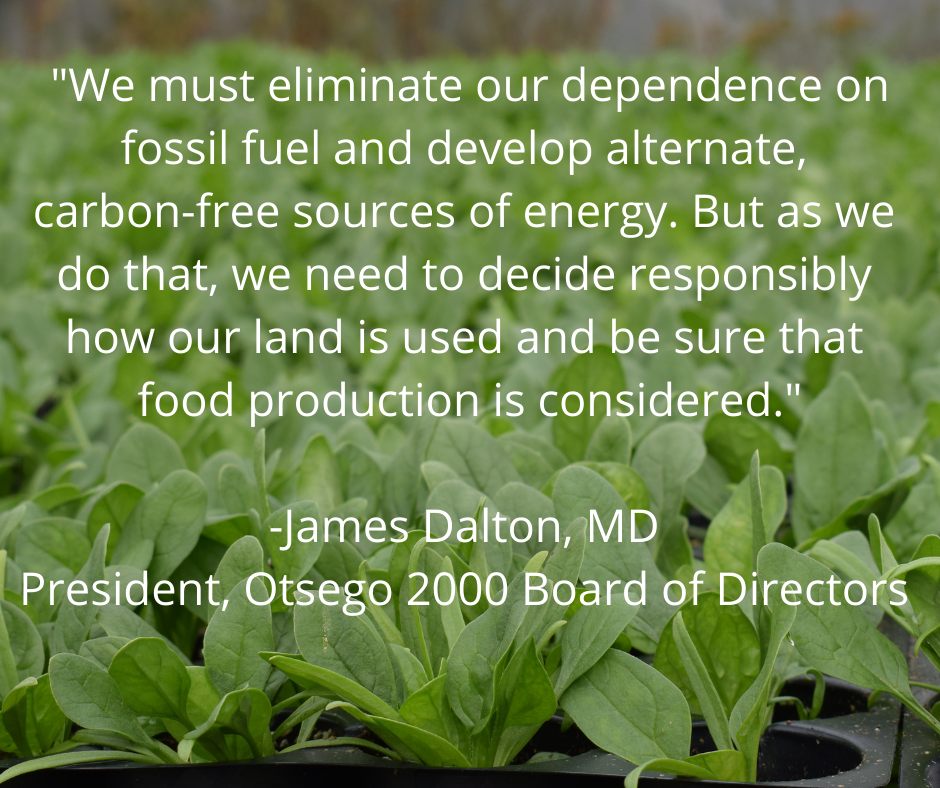Land Use, Energy and the Economic Future of Upstate New York
This editorial by Otsego 2000 Board President James Dalton, M.D. appeared in the April 28, 2022 issue of The Freeman’s Journal.
Climate change and land use are inextricably bound together. The collision between the two creates tension. We in New York State are experiencing that tension in multiple ways – not least of which is the drive to create more renewable energy through use of solar and wind-power generation on central New York farmland. There are currently proposals – some approved and some being considered - to develop large solar and wind “farms” throughout upstate New York, including Schoharie, Delaware, and Schenectady counties. In some cases, these projects will reduce or eliminate crop production from previously fertile farmland and reduce or eliminate grazing capacity for livestock. The result of this will be a reduction in agricultural productivity in central New York and removal of these lands from agricultural production for at least a generation.
Otsego 2000 is a nonprofit organization founded in 1981 with a mission to protect the historic, environmental, cultural, and agricultural resources of Otsego County and the greater Otsego Lake region. To be sure, part of that mission involves advocating for a transition to carbon-free energy resources. To that end, Otsego 2000 was instrumental in the elimination of hydrofracking for natural gas in New York and has advocated for responsible development of solar and wind energy production for local use. The large-scale production of solar and wind energy, however, can be quite a different proposition if it involves taking potentially productive farmland out of service or fragmenting the ecological integrity of natural systems.
Climate change is caused primarily by the overproduction of greenhouse gases. A transition to carbon-free forms of energy will help reduce the amount of additional greenhouse gases that accumulate in the atmosphere in the future. However, the U.N. Intergovernmental Panel on Climate Change has concluded that even if the world were to stop burning fossil fuels immediately, global temperatures will continue to rise for generations due to the climate-forcing impacts of emissions already pumped into the atmosphere. One of the implications of that rise in temperature will likely be an extended growing season in this region and the potential for New York State to take a much more prominent role in food production, nationally and internationally. This becomes even more likely given the drought and wildfires that are now perennial problems in the American West and Midwest. This is one reason for New York to be circumspect about use of prime agricultural land for something other than agriculture – even if it is something as worthy as clean energy production. Climate policy in New York has tended to diminish the importance of this factor and there is risk that current and future proposals will be approved without consideration of the resultant reduction of agricultural land use.
There are alternatives to the widespread conversion of prime farmland and nature to energy production. Wherever possible, priority should be given to the location of projects within already developed areas or brownfields, for example retail shopping centers with large parking lots, commercial buildings with rooftops that would be suitable for solar panels, industrial office parks with acres of open space, and landfills. Linear infrastructure corridors such as gas or electric transmission line easements may be suitable as well. Undoubtedly, it is cheaper to develop open farmland, but cheaper for whom? If we lose our ability to produce food, both regionally and nationally, that is certainly a long-term cost that we cannot afford. By focusing renewable projects within already developed areas, we can preserve farmland. This will retain our ability to provide healthy food for people throughout New York and the rest of the nation.
As part of a more balanced climate strategy, New York should also explore other carbon-free sources of energy. Nearly half of New York’s electricity is already carbon-free, and most of that comes from nuclear power and hydro. These are valuable sources of reliable baseload electricity that belong in our future.
State agencies estimate that in the decades ahead, New York will need nearly twice as much electricity as today—especially as vehicles, heating systems, and industry are electrified. A lopsided plan that blankets hundreds of square miles of New York with industrial-scale solar projects and erects thousands of wind turbines upstate, along with massive batteries, fuel cell plants, and four hundred miles of hydrogen-grade pipeline defies reality. A more inclusive strategy that embraces all viable tools in the toolbox will be essential for New York to meet its climate goals and prosper. More than aesthetics, our rural heritage and culture are at stake. Traveling through Delaware, Otsego, Schoharie, or Schenectady counties, one is struck by the breathtaking beauty of farmland, forests, rolling hills, and mountains. How will that be impacted by thousands of acres of industrial solar and wind projects? One of the largest contributors to our upstate New York economy is tourism, so the impact of large-scale solar and wind “farms” on the beauty of our rural landscape must be considered.
Finally, let’s not forget our farmers. Currently, the people who produce our food struggle economically to continue in that enterprise (particularly those in the dairy industry). They may find economic advantage by leasing their land to developers and decreasing their food production. The developers, not the farmers, then reap most of the profit on production of renewable energy from solar or wind technology. We must develop a system that values food production in an equitable fashion, so that there is incentive for farmers to keep farming.
Time is of the essence – scientists tell us that we are out of time as far as climate change is concerned. We must eliminate our dependence on fossil fuel and develop alternate, carbon-free sources of energy—and it must be NOW. But as we do that, we need to decide responsibly how our land is used and be sure that food production is considered. The economic future of central New York — which includes its future as a food producer, as a part of the development of renewable energy, and as a source of natural wonder and rustic beauty — is also an important factor.
James Dalton, M.D.
President, Otsego 2000 Board of Directors

